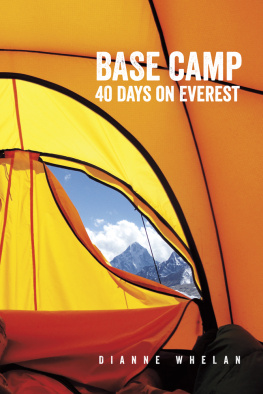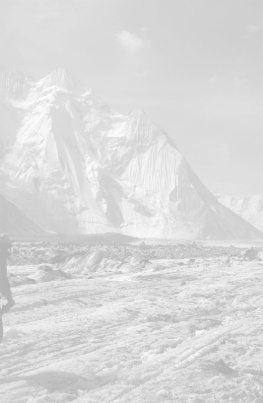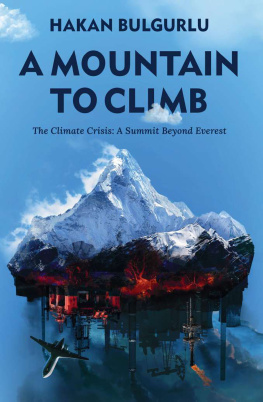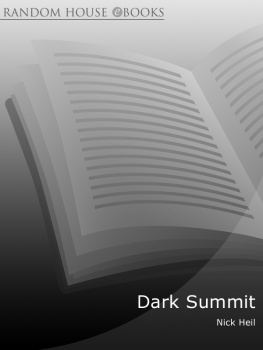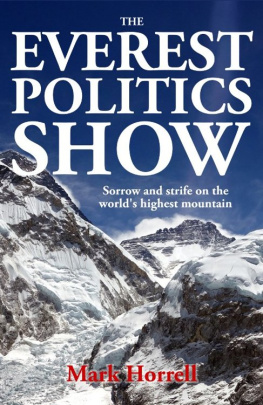Base Camp
40 Days on Everest
Dianne Whelan
Copyright 2014 Dianne Whelan
All rights reserved. No part of this publication may be reproduced, stored in a retrieval system or transmitted, in any form or by any means, without prior permission of the publisher or, in the case of photocopying or other reprographic copying, a licence from Access Copyright, the Canadian Copyright Licensing Agency, .
Caitlin Press Inc.
8100 Alderwood Road,
Halfmoon Bay, BC V0N 1Y1
caitlin-press.com
Edited by Jane Silcott.
Copy edit and EPUB by Kathleen Fraser.
Text design by Vici Johnstone.
Cover design by Edmund Arceo of Spiderplus Graphics.
Map illustration by Sheryl McDougald.
Caitlin Press Inc. acknowledges financial support from the Government of Canada through the Canada Book Fund and the Canada Council for the Arts, and from the Province of British Columbia through the British Columbia Arts Council and the Book Publishers Tax Credit.
Library and Archives Canada Cataloguing in Publication
Whelan, Dianne, 1965-, author
Base camp : 40 days on Everest / Dianne Whelan.
ISBN 978-1-927575-40-6 (EPUB)
1. Whelan, Dianne, 1965- TravelEverest, Mount (China and Nepal).
2. MountaineeringEverest, Mount (China and Nepal). 3. Everest, Mount
(China and Nepal)Description and travel. 4. Everest, Mount (China and
Nepal)Environmental conditions. I. Title.
GV199.44.E85W44 2014 796.522095496 C2013-908504-1
To know a people you must spend forty days with them.
Arabic proverb
Contents
Introduction
*
This is not a story about getting to the top of Mt. Everest. This is a story about what happens halfway up, at a place called Base Camp. At 5,364 metres, cradled in million-year-old granite, Base Camp is a barren wasteland incapable of sustaining life. Nothing grows there. It is not a place you would expect anybody to put up a tent, but every spring thousands do.
I got my first chance to go there in 2007, when I was hired by Outpost magazine to write a feature article about making the 92-kilometre trek to Base Camp. I was excited to go to the holy mecca of mountaineers, the mythic realm of Hillary and Tenzing. Ever since I was a child Ive been fascinated by the story of their first summit. There was something noble about it, a man from the east and a man from the west together achieving what was thought impossible, the dream that had already killed many of those who had tried. What I liked best: they never admitted who stood on top first.
It was a grey and cold day in late May when I arrived for that first visit. The camp consisted of hundreds of yellow, red, blue and green tents scattered across acres of ice and moraine. There was no even ground to stand on, and everywhere I looked I was surrounded by dirty ice, dark rock, garbage and melting glacier water. This was far from the pristine mountain scene Id expected; rather, it looked more like a temporary camp of refugees in a barren and inhospitable place. Nothing lives or grows at 5,300 metres. Nothing grows in the ground. There is only 50 percent as much oxygen in the air as there is at sea level. So it was hard on my body, triggering headaches, insomnia, and crazy dreams. Then I met a guy who told me about some oxygen being stolen from Camp Four. At this point my noble myth died. I was glad to leave after a few hours, and remarked to one of the women I was trekking with, I guess I can cross that off the bucket list, tick, no need to go back there again.
But for months after I returned I couldnt stop thinking about it: the ego, the selfishness, the garbage and the desecration of nature. I wanted to make a film about it.
So I returned in April 2010, this time to spend forty days on Everest filming an independent documentary called 40 Days at Base Camp.
It takes a climber about forty days to climb Everest. In part that was why I decided to spend that amount of time at Base Camp, but I was also thinking of the symbolic meaning that forty days has in just about every religion in the world as a period of self-reflection.
I read recently that we are not defined by what we want because we all want money, health, love and happiness. We are defined by what we are willing to suffer for, and I was willing to suffer to make this film.
I admit in the final days leading up to my departure, I got a bad feeling. The wheels were in motion, the financing and equipment were in place to go, tickets booked, so there was no turning back. But deep down, beneath my confident exterior, I was scared. I knew spending forty days on Everest was going to change my life. And it did.
This is the story of forty days at Base Camp.
Kathmandu
*
April 3, 2010
Our party of three arrives in Kathmandu from Canada late at night after thirty-two hours of travel with 900 pounds of gear in thirteen duffel bags. A red half moon in a black sky greets our arrival. Its good to arrive here late at night when the chaos of Kathmandu is sleeping. On empty streets we are ten minutes from our hotel, a journey that by day could easily take well over an hour.
At the hotel, there is strong coffee and fruit and eggs in a large dining room where the floor staff outnumber the handful of white guests. Hotel Shanker was once a palace when Nepal was a Hindu monarchy. That ended in 1990. Now, shadows of that greatness linger in the grey marble floors, the creamy clay arches, the glass chandeliers and the pillars painted with golden dragons with elephant heads and snake tongues. Dying myths are everywhere.
The gardens are well groomed, full of fuchsias and miniature palm trees, and this morning the air is fresh after the rain that washed away yesterdays dust and smog. We will spend three days in Kathmandu. At 1,400 metres, this is our first step in acclimatizing to higher altitudes as all three of us live at sea level back home.
Andrew Coppin is my director of photography. He is a kind and genuine man. He is thirty-two and fit, doesnt drink or smoke, and is what I call a technical cameraman. He likes technology, takes the time to understand it, and is methodical and disciplined. He was raised by a family of nuclear scientists and is an atheist. I saw a film he shot and liked his eye. And he had just spent six years working on The L Word as a camera assistant: all good signs. But it was for his left brain that I hired him. I am a very intuitive photographer and filmmaker. I smoke and drink. I was raised in a Catholic family and I read my horoscope faithfully. I dont have an aptitude for the science and math, but I have the feel for a good shot. So my right brain was looking for a left brain to bring on the journey. I found it in Andrew.
Teresa is my partner. We have been together for ten years. She is kind and generally calm, has beautiful blue eyes, and is the quintessential embodiment of the word yin. She has made the world slow down for me, made my house a home, and the simple moments of pleasure more seductive than the big adventures. With her, I have stayed still longer than I ever have in my life. She will travel with Andrew and me for the first two weeks of the trip, hike the beginning of the trail, then fly home to British Columbia as Andrew and I push on to Base Camp.

